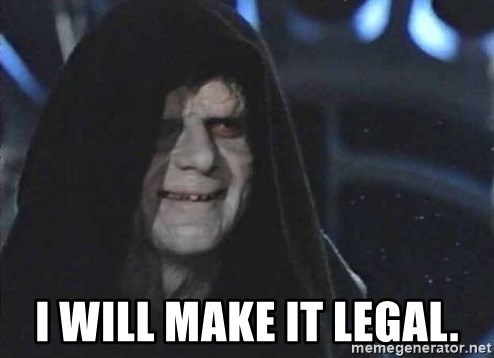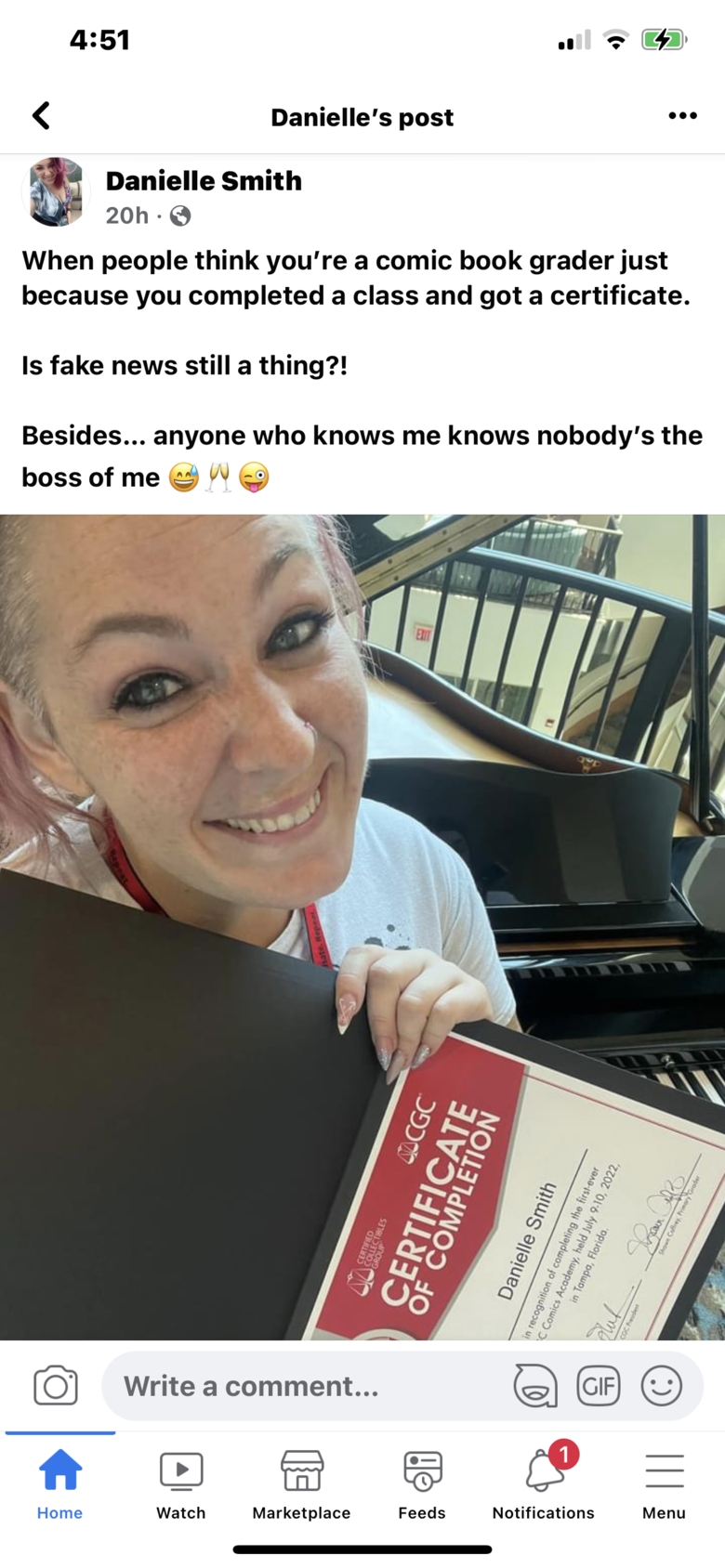CGC puts blue label on "new" modified excl18147
 past performance is no guarantee of future actions. past performance is no guarantee of future actions.
|
KatKomics private msg quote post Address this user | |
Quote:Originally Posted by GAC I've grown up and currently live in the Golden Horseshoe area yet I've never herd of a professional hockey team in Toronto..... are these "Maple Leafs" some sort of bear league team?? |
||
| Post 526 • IP flag post | ||
 Where's his Bat-package? Where's his Bat-package?
|
Byrdibyrd private msg quote post Address this user | |
Quote:Originally Posted by ComicNinja0215 And that's the issue right there. The grading is supposed to be about the integrity. Third party graders exist so that buyers can feel secure about what they're buying, and collectors know, without question, what's in their collections. Why do we even pay for their 'services' if their integrity is in question? |
||
| Post 527 • IP flag post | ||
 Masculinity takes a holiday. Masculinity takes a holiday.
|
EbayMafia private msg quote post Address this user | |
Quote:Originally Posted by dielinfinite It has similarities, but I'm guessing that A.R.T. Company didn't get a 3rd party certification service to certify it as an Annie LEE limited edition. |
||
| Post 528 • IP flag post | ||
 Where's his Bat-package? Where's his Bat-package?
|
Byrdibyrd private msg quote post Address this user | |
Quote:Originally Posted by EbayMafia Crux of the matter in a nutshell. Had A.R.T. Company done that, they would have lost their case. |
||
| Post 529 • IP flag post | ||
 " . " " . "
|
Davethebrave private msg quote post Address this user | |
| Completely distinguishable. The case (claim) cited below is more like claiming a CGC graded slab constitutes a potential copyright violation (encasement and fee/cost for the encasement that now includes information in addition to the original work). Obviously it doesn’t (and thanks to the case you cite, precedent is established). Quote: Originally Posted by dielinfiniteQuote: Originally Posted by dielinfinite |
||
| Post 530 • IP flag post | ||
 " . " " . "
|
Davethebrave private msg quote post Address this user | |
Quote:Originally Posted by Byrdibyrd Not even necessary to reference the certification element. The court distinguished based on the facts. In that case the art itself was not transformed or altered in any way. It was mounted and still visible as originally created. There are other more technical differences (technical re: application of statutory vs common law precedent) but unnecessary to dive into… the UF4 acetate cover would fail under the judgment of the case cited. This is because the cover is visibly altered as presented vs the original work. There are other issues (in favor of Marvel if they pursued this) but I’ll leave it at that. None of the above constitutes a legal opinion, just my personal quick interpretation ;-) |
||
| Post 531 • IP flag post | ||
 " . " " . "
|
Davethebrave private msg quote post Address this user | |
| Also, Judge Easterbrook is one of my favorite judges (in terms of his written opinions). So thank you for providing the link. | ||
| Post 532 • IP flag post | ||
 You can't get good wood on the ball every time. You can't get good wood on the ball every time.
|
HotKeyComics private msg quote post Address this user | |
| We will all know soon enough what Marvel did, if anything, if Clayton and Black Flag get another Marvel exclusive soon. | ||
| Post 533 • IP flag post | ||
 I'm waiting.... (tapping fingers). I'm waiting.... (tapping fingers).Splotches is gettin old! |
Nuffsaid111 private msg quote post Address this user | |
| Hopefully this closes this topic out for any future transgressions from Black Flag or any other pond scum retailers/dealers Taken from another site - sent from Marvel to retailers (apparently)  |
||
| Post 534 • IP flag post | ||
 Can the moderators change my profile caption to <snip> Can the moderators change my profile caption to <snip>
|
ComicNinja0215 private msg quote post Address this user | |
| Really looking forward to NYCC to see if they are there and whatever shenanigans the bring with them. | ||
| Post 535 • IP flag post | ||
 Can the moderators change my profile caption to <snip> Can the moderators change my profile caption to <snip>
|
ComicNinja0215 private msg quote post Address this user | |
| @Byrdibyrd |
||
| Post 536 • IP flag post | ||
 Collector Collector
|
Wraith private msg quote post Address this user | |
Quote:Originally Posted by Nuffsaid111you just know there's been some discussions behind closed doors.. I wonder if there's any with cgc? |
||
| Post 537 • IP flag post | ||
 " . " " . "
|
Davethebrave private msg quote post Address this user | |
| Almost as though publishing a bootleg variant that appeared official is illegal… | ||
| Post 538 • IP flag post | ||
 Where's his Bat-package? Where's his Bat-package?
|
Byrdibyrd private msg quote post Address this user | |
Quote:Originally Posted by Wraith You know it. To have been a fly on the wall... |
||
| Post 539 • IP flag post | ||
 Can the moderators change my profile caption to <snip> Can the moderators change my profile caption to <snip>
|
ComicNinja0215 private msg quote post Address this user | |
 Black flag be like ... |
||
| Post 540 • IP flag post | ||
 Where's his Bat-package? Where's his Bat-package?
|
Byrdibyrd private msg quote post Address this user | |
| @ComicNinja0215 Marvel be like: "...all cover artwork must be created and approved by Marvel." This is code for 'we will destroy you if you do not comply.' |
||
| Post 541 • IP flag post | ||
 Can the moderators change my profile caption to <snip> Can the moderators change my profile caption to <snip>
|
ComicNinja0215 private msg quote post Address this user | |
| @Byrdibyrd Marvel: I am Inevitable lol | ||
| Post 542 • IP flag post | ||
 would be nice to have a snugger fit. would be nice to have a snugger fit.
|
Sigur_Ros private msg quote post Address this user | |
Quote:Originally Posted by Byrdibyrd The Disney mentality. Anyway, we'll see. They may do nothing. Pretty sure the message was understood a week ago. |
||
| Post 543 • IP flag post | ||
 Thank you sir. May I have another? Thank you sir. May I have another?
|
Siggy private msg quote post Address this user | |
Quote:Originally Posted by ComicNinja0215 I think I saw that. Welcome back. Quote: Originally Posted by ComicNinja0215 |
||
| Post 544 • IP flag post | ||
 Can the moderators change my profile caption to <snip> Can the moderators change my profile caption to <snip>
|
ComicNinja0215 private msg quote post Address this user | |
| @Siggy ty! | ||
| Post 545 • IP flag post | ||
 It gets old smelling it everytime I go outside my door. It gets old smelling it everytime I go outside my door.
|
Nearmint67 private msg quote post Address this user | |
 |
||
| Post 546 • IP flag post | ||
 I’m not an ant. I’m a rootin tootin Hornet! I’m not an ant. I’m a rootin tootin Hornet!
|
Zombie_Head private msg quote post Address this user | |
Hmmm nerdy girl still at it. Lol |
||
| Post 547 • IP flag post | ||
 I’m not an ant. I’m a rootin tootin Hornet! I’m not an ant. I’m a rootin tootin Hornet!
|
Zombie_Head private msg quote post Address this user | |
| But she only got 75 copies lol | ||
| Post 548 • IP flag post | ||
 I've spent years perfecting my brand of assholery. I've spent years perfecting my brand of assholery.
|
DrWatson private msg quote post Address this user | |
| What does that even mean? | ||
| Post 549 • IP flag post | ||
 I'd like to say I still turned out alright, but that would be a lie. I'd like to say I still turned out alright, but that would be a lie.
|
flanders private msg quote post Address this user | |
Quote:Originally Posted by DrWatson Also confused. Why would you take a CGC grading class? Is it similar to the ITT Tech scam? Or are you refering to how "nobody's the boss of [her]", implying she is either self employed or on welfare. |
||
| Post 550 • IP flag post | ||
 Masculinity takes a holiday. Masculinity takes a holiday.
|
EbayMafia private msg quote post Address this user | |
| Apparently Nerdy Girl has a favorite selfie pose and a signature head tilt. | ||
| Post 551 • IP flag post | ||
 past performance is no guarantee of future actions. past performance is no guarantee of future actions.
|
KatKomics private msg quote post Address this user | |
Quote:Originally Posted by Zombie_Head sheeetttt..... does this mean she is just as or even more 'qualified' than that EGS guy??!! |
||
| Post 552 • IP flag post | ||
 I've spent years perfecting my brand of assholery. I've spent years perfecting my brand of assholery.
|
DrWatson private msg quote post Address this user | |
Quote:Originally Posted by flanders I know Danielle, not personally per se, but I've met her and her boyfriend/husband/significant other. They're not on welfare. They're self employed in the comic business. Her b/h/so deals in some very nice books. Adam aka Filter81 on the cgc boards. Very nice guy. He's quiet and reserved. She's boisterous and outgoing. |
||
| Post 553 • IP flag post | ||
 I've spent years perfecting my brand of assholery. I've spent years perfecting my brand of assholery.
|
DrWatson private msg quote post Address this user | |
Quote:Originally Posted by EbayMafia Don't they all? |
||
| Post 554 • IP flag post | ||
 Where's his Bat-package? Where's his Bat-package?
|
Byrdibyrd private msg quote post Address this user | |
Quote:Originally Posted by DrWatson I'll take your word for it. I don't look too closely at that on other people's hubbies. Gets me in trouble. |
||
| Post 555 • IP flag post | ||
This topic is archived. Start new topic?
